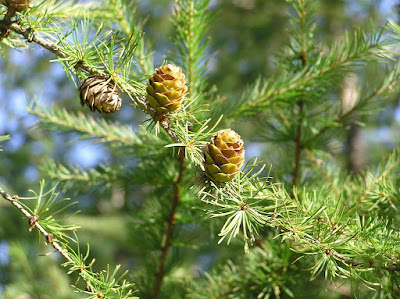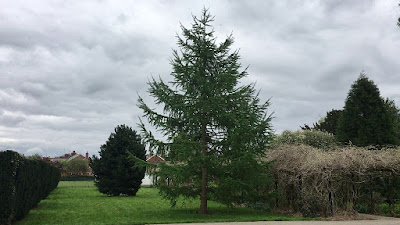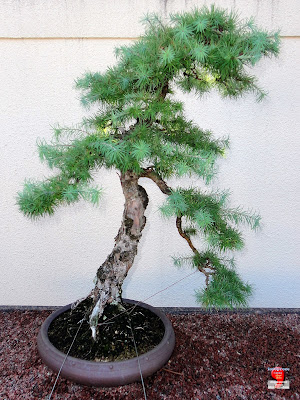Larix kaempferi is endemic to central Honshu, Japan. It occurs on well-drained soils, avoiding waterlogged ground from the hills to high in the mountains (500 - 2300 meters above sea level). It is hardy to USDA Hardiness Zone 4 to 6.
Larix kaempferi also called as Japanese larch, Karamatsu, Pseudolarix kaempferi, is a species of the genus Larix. This species was described by Élie-Abel Carrière in 1856. The scientific name honors Engelbert Kaempfer - a German naturalist, physician, and explorer writer.
IDENTIFY LARIX KAEMPFERI - JAPANESE LARCH PLANTS
Larix kaempferi is endemic to central Honshu, Japan. It occurs on well-drained soils, avoiding waterlogged ground from the hills to high in the mountains (500 - 2300 meters above sea level). It is hardy to USDA Hardiness Zone 4 to 6.
Japanese larch is a deciduous coniferous tree which reaching up to 40 m tall with to 1.5 m in diameter trunk and broadly pyramidal, dense crown. The long branchlets are light yellow or light reddish brown,, turning grayish brown or blackish brown in 2nd year. The short branchlets bearing rings of scale remnants. The leaves are linear-oblanceolate, 1-2.5 cm x 0.7-1.1 mm, inconspicuously keeled abaxially, apex obtuse. The seed cones terminal, violet, maturing orange-brown tinged with purple, finally gray-brown, ovoid-globose. The seeds are brownish white mottled with red.
This larch is used for ornamental purposes in parks and gardens. The wood is tough and durable, used for construction, railway sleepers, pit props and the pulp industry. Small larch poles are widely used for fencing. It is also widely used as material for bonsai.
LARIX KAEMPFERI - JAPANESE LARCH PLANTS CARE AND CULTIVATION
The cultivation of these plants presents no special difficulties, if proper soil and exposure are available. The question of hardiness is, of course, all-important. It is not only the problem of temperature the given tree will stand, but also the exposure to winds, and, to a considerable extent, the source from which the tree is derived. If the plants are raised from seeds matured in similar or even more rigorous climates, they are usually more hardy.
Soils:
Larix kaempferi prefer a well-drained porous gravelly subsoil, overlaid with a light sandy loam. They seem to be particularly happy in a soil underlaid with a porous glacial drift. In cultivation, however, they succeed very well in ordinary well-drained soil. When the plants are set in clay soil, which is often done, the soil should be thoroughly loosened by trenching or subsoil plowing, and well underdrained. Any available humus, woodashes, and well-rotted manure incorporated in the soil greatly aid in rendering it friable and porous for the roots.
Manures and mulches:
Mulching with ordinary well-rotted barnyard manure in late autumn affords much stimulus to growth. By the following spring the manure will be in a desiccated condition and can be incorporated with the soil. A heavy mulch of old straw, rotten hay, or any similar material over the roots, and this was maintained throughout the entire growing season is benefit to the plants in a more or less juvenile condition.
In many cases manure is not obtainable. In such event, newly moved plants should be heavily mulched with rotten straw, rotten hay, or any similar rubbish for a few years until they become established. The frequent stirring of the ground over the roots subsequently will conserve sufficient moisture.
An area extending from the stem to one to two feet beyond the branches, stirred up with hoe and rake perhaps five or six times throughout the growing season, is very beneficial in conserving the moisture around the roots.
Pruning:
Removal of the lower branches of Japanese larch is a serious mistake, and, if healthy, they should be retained to the base. Pruning or disbudding can be intelligently performed to add much to the natural symmetry. The extraction or removal, early in spring, of the central or terminal bud, will tend to compel the branches which start from the side buds to spread apart and form a much denser growth. Cutting back the previous year's terminal growth to a strong bud or branchlet on the main limbs over the tree, if the plant is inclined to be thin in its branching, always produces a much denser lateral growth.
Transplanting:
Transplanting can be done at all times of the year, excepting midsummer when they are in full growth. The best success is secured in spring when the buds begin to swell. From the end of August to the middle of September, if there have been abundant rains and the ground has been well soaked, is a very good time to move the plants. They may be planted late in autumn when circumstances compel it, but there is likely to be a considerable percentage of loss. Their roots are very susceptible to injury from exposure to the air, and the utmost vigilance should be exercised to keep them covered and moist.

















COMMENTS